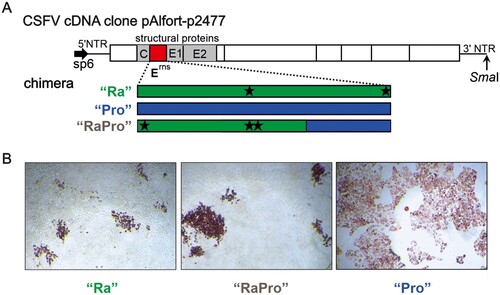Figures & data
Figure 1. Construction and characterization of chimeric pestiviruses. (A) Genome structure of the chimeric CSFV vaccine candidates. The reverse genetic system allows to generate synthetic genome-like RNAs of CSFV Alfort-p2477 by sp6-driven RNA synthesis after plasmid linearization with SmaI. The chimeric derivatives of CSFV designated “Ra”, “Pro” and “RaPro” contain the Erns coding sequences of the Norway rat and Pronghorn pestiviruses or a combination of both, respectively. Adaptive mutations identified in the “Ra” and “RaPro” vaccine stocks are indicated as asterisks. (B) Porcine kidney cell cultures three days after infection with the chimeric pestiviruses “Ra”, “RaPro” and “Pro” and visualization by immunoperoxidase staining with the pestivirus specific mab BVD/C16.

Figure 2. In vivo characterization of chimeric vaccine candidates. (A) Experimental design. Groups of five pigs were vaccinated each, only the unvaccinated group (challenge control) consisted of three animals. Time points of sampling are indicated below the time axis. Three severely diseased animals of the attenuation control group were sacrificed 18 dpi (†) and finally sampled. (B) Body temperature (top) and clinical presentation (bottom). Clinical scores were calculated as previously proposed by Mittelholzer [Citation20] with slight modifications as described earlier [Citation16]. (C) Time course of blood cell parameters. Reference ranges for leucocytes (10–22 G/l) and for thrombocytes (201–737 G/l) are highlighted in grey. (D) Genome equivalents (GE) of vaccine candidates in the blood and shedding via saliva and faeces.
![Figure 2. In vivo characterization of chimeric vaccine candidates. (A) Experimental design. Groups of five pigs were vaccinated each, only the unvaccinated group (challenge control) consisted of three animals. Time points of sampling are indicated below the time axis. Three severely diseased animals of the attenuation control group were sacrificed 18 dpi (†) and finally sampled. (B) Body temperature (top) and clinical presentation (bottom). Clinical scores were calculated as previously proposed by Mittelholzer [Citation20] with slight modifications as described earlier [Citation16]. (C) Time course of blood cell parameters. Reference ranges for leucocytes (10–22 G/l) and for thrombocytes (201–737 G/l) are highlighted in grey. (D) Genome equivalents (GE) of vaccine candidates in the blood and shedding via saliva and faeces.](/cms/asset/741ce5cf-ff44-40c3-9e18-06930ee5672d/temi_a_1826893_f0002_oc.jpg)
Table 1. Characteristics of CSFV strains and vaccine candidates.
Table 2. Detection of CSFV genomes in selected tissues.
Figure 3. Characterization of the humoral immune response and DIVA properties. (A). Mean neutralizing titers [ND50] of three independent titrations and standard deviations. The three rows show the kinetics of neutralizing Ab induced after vaccination with the “Pro”, “RaPro” and “Ra” chimera and subsequent challenge infection. Virus neutralization was performed with the homologous parental CSFV strain Alfort-p2477 (genotype 2.3) and the heterologous highly virulent challenge virus Koslov (genotype 1.1). (B) Seroconversion and DIVA properties of the vaccine candidates. Detection of CSFV specific antibodies was performed by conventional E2 Ab ELISA (upper panel) and DIVA Erns Ab ELISA (lower panel). Shaded boxes indicate doubtful ranges in the respective ELISAs; values above are positive and values below are negative.
![Figure 3. Characterization of the humoral immune response and DIVA properties. (A). Mean neutralizing titers [ND50] of three independent titrations and standard deviations. The three rows show the kinetics of neutralizing Ab induced after vaccination with the “Pro”, “RaPro” and “Ra” chimera and subsequent challenge infection. Virus neutralization was performed with the homologous parental CSFV strain Alfort-p2477 (genotype 2.3) and the heterologous highly virulent challenge virus Koslov (genotype 1.1). (B) Seroconversion and DIVA properties of the vaccine candidates. Detection of CSFV specific antibodies was performed by conventional E2 Ab ELISA (upper panel) and DIVA Erns Ab ELISA (lower panel). Shaded boxes indicate doubtful ranges in the respective ELISAs; values above are positive and values below are negative.](/cms/asset/19fb22cf-0662-4fd7-a746-e6608db9fc07/temi_a_1826893_f0003_oc.jpg)
